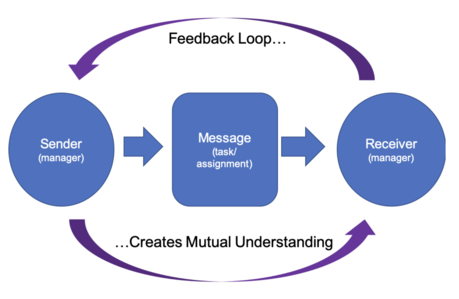A seasoned manager recently shared his challenges about one of his employees. The manager was frustrated because he would delegate work to this employee and most of the time what the employee delivered was not what the manager expected.
In further speaking to the manager, he said “I communicate, communicate, and communicate but the employee still doesn’t deliver what I ask.” Thus, the manager felt there was a performance issue brewing.
- Has this ever happened to you?
- Have you ever delegated a task to an employee and didn’t get back what you expected?
Unfortunately, it’s a very common occurrence across many industries.
Let me ask you this…
When you delegate a task is it one-way communication? For example, do you tell the employee what to do without allowing for two-way dialogue?
Many times managers think they are communicating and in actuality haven’t communicated in a way that fosters mutual understanding in order for the employee to deliver what is expected.
A typical one-way communication model looks something like this…

Sender (manager) has a Message (task/assignment) for a Receiver (employee).
What managers may not realize is the Sender (manager) and the Receiver (employee) both have “internal barriers” in their head that prevents them from truly listening. When facilitating leadership training and I go around the room and ask managers for examples of what types of internal barriers exist, I hear work related examples such as… “another pressing assignment,” “work crisis/issue,” “prepping for a meeting” to personal related examples such as “being hungry, “dinner plans,” “child’s baseball game,” “vacation plans” and so forth. However, these “internal barriers” prevent us from truly listening to ensure what we are hearing is processed correctly.
In addition to this, the Sender (manager) and the Receiver (employee) both have “external barriers” that exist that prevent them from truly listening. Examples of external barriers can be outdoor noise such as cars/sirens and construction or indoor noise such as people talking loudly nearby, people coming in and out of the office/area, being on your phone or computer while communicating, and so on.
No wonder why the performance outcomes we get back from our employees may not be what we expected. Did we allow for clarity? Did we give our employees a chance to ask questions in order to ensure mutual understanding which then affords them the ability to meet or surpass our expectations?
So when managers “tell” employees what to do without allowing for two-way dialogue they may have done a disservice to their employees. Managers may have increased the chance that what the employee delivers is not what was expected of them.
So, is it really a performance issue the employee has or taking a better look at how we (as managers of people) communicate to ensure mutual understanding?
A simple way to create two-way dialogue is after you “tell” your employee what you need them to do, PAUSE and ASK questions, such as:
“What questions do you have?”
“How can I help support you?”
“What other information might you need from me?”
“Would you like to schedule some check-in meetings together to help you?”
Listening to the employee and asking these types of questions immediately opens up a dialogue and increases the chance that what you expect of the employee is what they will deliver… or more.
Here is what a two-way communication model looks like:

Sometimes employee will “manage up” and if you don’t provide an opportunity to ask questions, they will.However, you certainly don’t want to rely only on this.
No one wants to spend time doing things that aren’t what is really expected of them, and all of us work hard to meet or exceed manager expectations.
So set your employees up for success by ensuring you do moreASKINGversus telling when delegating and communicating tasks to your employees.
By creating two-way dialogue and mutual understanding, you will be able to accelerate performance outcomes, create better efficiencies and less distractions while creating a more engaged, achievement driven environment.pe your paragraph here.
https://www.linkedin.com/pulse/what-i-expected-jennifer-miraglia/
